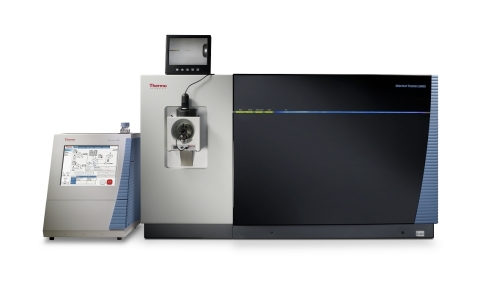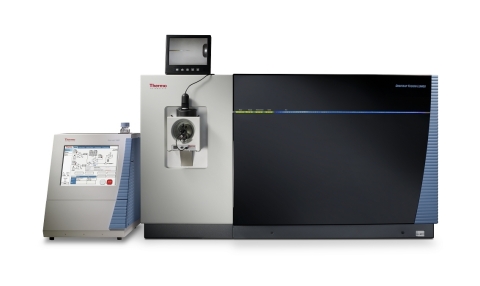ST. LOUIS--(BUSINESS WIRE)--Scientists performing advanced research in proteomics, biopharma and metabolomics can now achieve new limits of detection, characterization and quantitation with the newest tribrid mass spectrometer from Thermo Fisher Scientific.
As the latest addition to the company’s pioneering line of Thermo Scientific Orbitrap Tribrid mass spectrometers, the Thermo Scientific Orbitrap Fusion Lumos Tribrid Mass Spectrometer (MS) is designed to expand performance in advanced proteomics, biopharma and metabolomics applications, including quantitation using isobaric tags, low level PTM analysis, data independent acquisition (DIA), and top-down proteomics. The new instrument features enhanced sensitivity resulting in improved analyte detection, characterization and quantitation, enabling scientists to perform more comprehensive sample analyses faster and with better accuracy than ever before.
The Orbitrap Fusion Lumos MS will be exhibited for the first time at the 63rd Annual American Society for Mass Spectrometry Conference, Booth 140, and at the Landmark Suite at the Renaissance Hotel in St. Louis.
“Scientists pushing the limits of quantitation and protein characterization require more expansive and in-depth analytical information,” said Ken Miller, vice president of marketing, life science mass spectrometry for Thermo Fisher Scientific. “The broad advances made in our new-generation Orbitrap Fusion Lumos MS instrument deliver increased sensitivity and an enhanced feature set to improve structure analysis and characterization. The combination of impressive new performance, flexible Tribrid system design and intelligent ADAPT technology make the new Orbitrap Fusion Lumos MS system an absolutely essential tool for high-end life science research.”
For example, in the systems biology lab of Professor Steven Gygi, PhD, at Harvard Medical School’s Department of Cell Biology, Boston, Mass., scientists rely heavily on data generated from mass spectrometers and require the most advanced technology for deep sequencing analyses. “The more sensitive the mass spectrometer, the more accurate the resulting data, contributing to a more comprehensive analysis of proteomic samples,” said Dr. Gygi. “Our experience with the Orbitrap Fusion Lumos MS instrument has been entirely positive. The sensitivity improvements represent a huge step forward for multiplexing experiments where up to 10 samples are combined. The goal of 10,000 proteins quantified simultaneously across 10 samples in a single day is now within reach.”
In top-down proteomics laboratories, researchers such as Neil Kelleher, PhD, Professor of Chemistry, Molecular Biosciences and Medicine at Northwestern University, are pushing the limits for whole proteome analysis. “The Orbitrap Fusion Lumos MS is an instrument I see improving all of the three main needs for top-down proteomics: quantitation, identification and characterization,” said Dr. Kelleher. “I am particularly keen to leverage the Lumos for fast and deep proteoform-resolved measurements of precious clinical samples in our translational research here at Northwestern. We can achieve quantification and identification of more proteoforms, and with greater characterization power, all from the same number of LC-MS injections.”
To achieve proteome-wide coverage, the Orbitrap Fusion Lumos MS combines the versatility of a Tribrid system with the selectivity of Orbitrap technology and sensitivity rivaling that of a triple quadrupole instrument. The new features include:
- Brightest ion source – up to 5x improvement in limits of quantitation for peptides and small molecules compared to the Orbitrap instruments equipped with a conventional source.
- Segmented quadrupole mass filter powered by Advanced Quadrupole Technology – increase in selectivity of the analysis by improving isolation resolution, ion transmission and peak shape
- Advanced Vacuum Technology – enhancement in detection limits by improving transmission of ions to the Orbitrap mass analyzer
- High-Definition Electron-Transfer Dissociation (ETD HD) – improvements in dynamic range and detection limits by performing ETD reaction on a larger precursor ion population, enabling greater sequence coverage in less time
- ADAPT Technology – adjusts key parameters “on-the-fly” without prior knowledge of sample amount, enabling maximum protein identifications from samples of unknown concentration in a single run preserving the sample and saving time.
For more information on the Thermo Scientific Orbitrap Fusion Lumos Tribrid Mass Spectrometer visit www.thermoscientific.com/lumos.
About Thermo Fisher Scientific
Thermo Fisher Scientific Inc. is the world leader in serving science, with revenues of $17 billion and approximately 50,000 employees in 50 countries. Our mission is to enable our customers to make the world healthier, cleaner and safer. We help our customers accelerate life sciences research, solve complex analytical challenges, improve patient diagnostics and increase laboratory productivity. Through our premier brands – Thermo Scientific, Applied Biosystems, Invitrogen, Fisher Scientific and Unity Lab Services – we offer an unmatched combination of innovative technologies, purchasing convenience and comprehensive support. For more information, please visit www.thermofisher.com.




